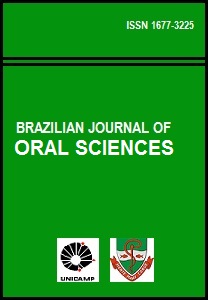Abstract
Aim: This study evaluated the surface roughness, topography and permeability of bovine enamel by profilometry and scanning electron microscopy (SEM) with and without silver nitrate solution, after exposure to different bleaching agents. Methods: Fifty-two enamel samples were randomly divided into four groups (n=13): CP16% –16% carbamide peroxide - Whiteness Perfect; HP6% - 6% hydrogen peroxide - White Class; HP35% - 35% hydrogen peroxide Whiteness HP Maxx; and Control - not bleached and kept in artificial saliva. For roughness analysis, average surface roughness (Ra) and flatness coefficient (Rku) parameters were used. The topography and permeability were examined by SEM. For permeability evaluation, the samples were immersed in a 50% silver nitrate solution and analyzed using a backscattered electron and secondary electron mode. Results: For the roughness (Ra) evaluation, Kruskal-Wallis and Wilcoxon Signed Ranks Test were used, showing an increase on the surface roughness in all bleached groups. The Rku parameter suggested changes on enamel integrity. The SEM micrographs indicated changes on enamel topography and different levels of silver nitrate penetration in the samples of the bleached groups. In the overall analysis, the bleaching agents promoted surface changes and higher silver nitrate penetration when compared to the control group. Conclusions: It may be concluded that different bleaching agents might alter the topography and roughness of enamel surface. Moreover, the higher infiltration of silver nitrate suggests an easier penetration path for the oxygen molecules into the dentin substrate.The Brazilian Journal of Oral Sciences uses the Creative Commons license (CC), thus preserving the integrity of the articles in an open access environment.
Downloads
Download data is not yet available.

